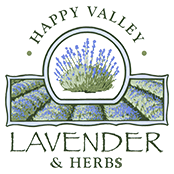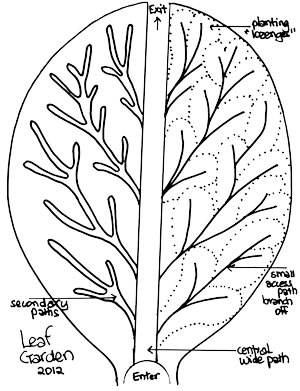|

May 2012
The Path to Production
New Veggie garden design ...
I am trying something new this year for my glorious jumble of veggies, herbs and flowers. It is more of a subtle shift in my mind as much as in real time and soon, physically in my gardening space. It all began with my interest and research dipping into “Keyhole” gardens and then wanting to build one myself ... but where? The idea just did not flow in my country style property and felt more like a “wishing well” design that would only be plunked in my Nursery area for “Show ‘n Tell” ... I more or less resigned myself to making one for someone else, somewhere else.
Mother Nature has her own way of nudging us, even sending the most unlikely agents to drop into our lives to nudge us when an opportunity in our thinking allows a gap. It felt like an opportunistic Johnny-jump-up literally leaping into my path with its bright little face and making me smile when my daughter’s metal working boyfriend lent me a book called Gaia’s Garden by Toby Hemenway. The one gardening book he read cover to cover even while living in a 4th floor condo in Cook Street village ... ISBN 978 1-60358-029-8
Paths ... paths were the “road” to better production in our veggie gardens. It explained the very basic premise of the waist high Keyhole gardening then dropped the idea on the ground literally, to expand it for more traditional flat in-the-ground row and path styled veggie gardens, big or little.
What caught my attention were the sketches of the efficiency of Mother Nature’s highways or pathways we look at every day; the “spiral pathways” in seashells, the “mesh pattern” in honeycomb, the “net pattern” in spider webs, the “veining” of blood vessels to the brain like a visual cross section of the curved pathways in a cauliflower and then the “branching” pattern of veins in a basic leaf. These are all potentially very efficient planting grids to disperse and deposit water, provide nutrients and care, and maximize our planting areas with minimal pathways in our veggie garden!
My favourite and current inspiration: the simple “branch” veining of leaves. So 2012 is my “Leaf Garden” plan. A simple yet dynamic shift in my thinking and my paths leading to more production and less paths ~ all from Natures patterns!
Think of the veining on a leaf of Sage ...
My veggie patch is essentially one big rectangle, east to west, divided by an extra wide central path or “vein” to encourage the public to enter my veggie garden area with ease, not step on anything planted, and check out both side rectangles of planting with wheelbarrow access for me. This will not change in design.
I will abandon the overall practise of one row of veggies, one path, and then the next row of veggies and another path; all at 180 degree right angles from top to bottom along this center path. My secondary footpaths or small veining will now angle at about 45 degrees, with small “tributaries” possible for occasional use when weeding or harvesting. The planting area around the secondary access will be more of a lozenge shape where I can interplant, say; lettuce, carrots and onions together. The idea behind this also being ~ curved or wavy edges have more planting area available than a straight line.
I have always used a South American “net” grid pattern to plant my block of corn. I plant 4 seeds in a cluster every 9 inches in every direction to maximize wind pollination and cob production, reduce weeds and allow me to peg a net around the perimeter so I get the harvest instead of the coons! Between corn varieties, I leave a body width for harvesting, marking which rows ripen first ... but again a patterned layout with fewer pathways.
I have also always planted my Basil in a tight 4 row grid through black landscape cloth on a raised berm. This allows me a specific area to build up any extra nutrition and the cloth cover encourages the soil to warm up for the overall Basil planting site. A similar site is prepped for Tomatoes with an added tall hooped piping over the site to throw a plastic cover over and again create a micro climate.
These concentrated planting practices reduce extra pathways, allow special requirements and help increase production. Plus they are simple portable enhancements to allow yearly crop rotation plans.
Do keep in mind; any planting blocks must not be so wide that you can not weed them easily from the outer edges, thereby not needing to step in the middle of the bed and keeping your soil fluffier and not compacted for developing fragile new roots.
This book Gaia’s Garden, subtitled ... A Guide to Home-Scale Permaculture also goes on to look at your whole property and planning the landscaping in “waves” or zones starting from your house. It looks at where your daily trips go in the yard and garden. Zone 1 starts with your patio planting of herbs and salad “fixings”, perhaps a small lawn for children. Zone 2: Footpaths to useful berry shrubs, row crops, pond: chickens anyone?! Zone 3: Seasonal larger fruit and nut tree area. Zone 4: A wandering walk amongst shade and boundary trees with perhaps a wilder hedgerow area at your outer edges for birds, bees, butterflies and other helpful insects. There is a ton of information and insights to create a balanced ecological garden space ~ all this on a quarter acre ... hmmm Possibilities!
So take out your plan for 2012, see if any of these ideas are helpful as you move from plans on paper or in your head, to lovely warming spring soil. Home gardeners ~ this is your gardening window to start up all your green thumbs! The only fuel needed is inspiration, possibilities and a tin full of seeds.
Happy Gardening ~ Lynda
Originally published in the May 2012 edition of the Metchosin Muse
Printable Version 
|


